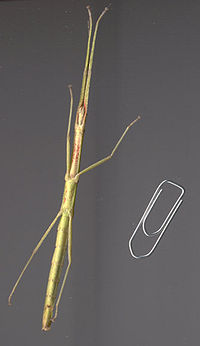- Carausius morosus
-
Carausius morosus 
Carausius morosus from India Scientific classification Kingdom: Animalia Phylum: Arthropoda Class: Insecta Order: Phasmatodea Suborder: Verophasmatodea Family: Diapheromeridae Genus: Carausius Species: C. morosus Binomial name Carausius morosus
Sinety, 1901Carausius morosus (the 'common', 'Indian' or 'laboratory' stick insect) is a species of phasmid that is often kept by schools and individuals as pets. Culture stocks originate from an original collection from Tamil Nadu, India. Like the majority of the phasmatodea, they are nocturnal. Culture stocks are parthenogenetic females that can reproduce without mating. There are no reports of males, although in captivity gynandromorphs (individuals with both female and male characteristics) are sometimes reared.
Contents
Description
Females are elongated and approximately 80–100 mm in length. The front legs have red patches at the base of the forelegs, and similar but yellow patches on the mid-legs. Eggs are ovoid and brown, with a beige plug at one end. When the eggs hatch, the plug opens and dark, tiny, string-like young crawl out of the opening. The eggs are haploid.
Behaviour
When disturbed the major defence method is feigning death, the body becoming rigid, and the legs held along the line of the body.
Feeding occurs at night, when the insects are active. During the day they rest (often with legs in line with the body) on their foodplants.
Care in captivity
This is an easy species to rear, feeding on fresh privet, ivy or bramble. They need to be kept in a cage around 25 cm in height to allow for successful moulting. Females will lay eggs shortly after reaching adulthood, at the rate of several per night. These can be hatched by keeping them on dry paper towel, or in a dry dish. Eggs can take four months to hatch, depending on many factors including temperature. This is species number 1 on the Phasmid Study Group Culture List
Accidental introductions
Accidental introductions have been recorded around the world, including South Africa, Great Britain and the USA. The last has been more problematic than most, with many reports from gardeners of the insects reaching pest proportions, especially in Orange County.
External links
Categories:- Phasmatodea
- Animals described in 1901
Wikimedia Foundation. 2010.
